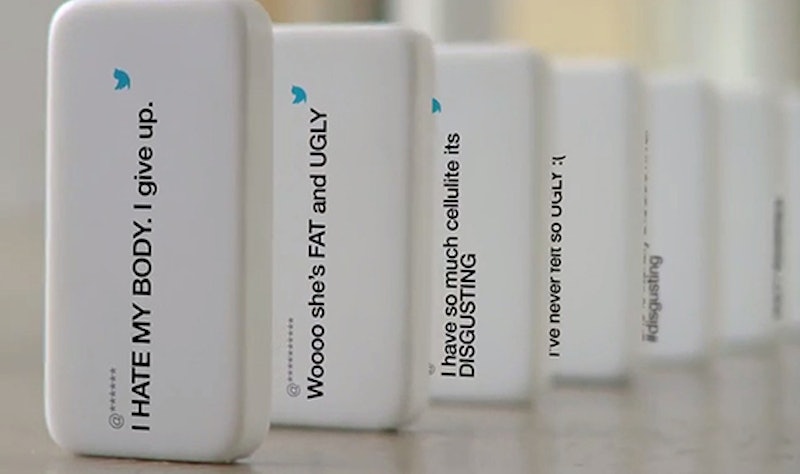Life
Find Out Which Words You Use Most Twitter

Guess which month sees women writing the most negative tweets about their own or other people's bodies? March. That's according to new research by Dove, which has launched a new tool with Twitter as part of its #SpeakBeautiful initiative to help users see what kinds of words they use most on the platform, and even what times of day they're most likely to tweet negative things about their own or others' appearances.
Unveiling the new tool at South By Southwest in Austin this past Saturday, social media scholar and teen researcher danah boyd noted that one in three girls report feeling inadequate when they see images of other girls on social media, and that eight out of 10 women report encountering negativity on social media. (Honestly, I'd like to meet the two out of 10 women who don't, and ask them their secret.) There's a contradiction, however, between what women report encountering and what they cop to themselves perpetuating — only nine percent of women Dove surveyed admitted to participating in negative behavior online themselves.
The numbers don't add up; clearly, many of us are being more negative or hurtful online towards ourselves or others than we care to admit — or perhaps, critical language is so embedded in our society that we don't even realize we're perpetuating it.
"Even though many girls are struggling with insecurity, they know they're not 'supposed' to, and it's that tension that becomes so salient as they try to navigate social media," Boyd said. "And in response, they judge others; they say negative things about others in an attempt to come to terms with their own insecurities, their own emotions. It's all wrapped up in itself. They rarely admit to talking negatively about others, but they will admit to talking negatively about themselves."
That contradiction, and the fact that 65 percent of girls surveyed said they want to learn how to use social media more positively, led Dove to partner with Twitter to create the #SpeakBeautiful Effect — a new technology that they say reads between the lines of your tweets "to reveal the emotional impact of your online words". And the results are pretty interesting.
What The #SpeakBeautiful Effect Tells You
Here's how it works: you simply go to this link, and retweet Dove's link.
Within minutes, you receive your report back from Dove. Here's how mine looked:
I'd be lying if I said I wasn't relieved. Hear that guys? I'm inspiring! Here's my report.
1. How Positive You Are On Social Media
I love that my most common emotion is love, I have to say.
2. Which Image-Related Words You Tweet Most
Here, the #SpeakBeautiful Effect tells me which image-related "positive" and "negative" words I use most.
Keep in mind that I mostly tweet Bustle articles I write and edit, which are often about sex and relationships, so that obviously influences my data. (I was surprised to see I say "smile" so much though, honestly.)
As plus-size Styleit blogger Sarah Conley noted on Dove's panel for the #SpeakBeautiful Effect's launch, it's up to you to interpret the information from the report as you wish, and to use it as a jumping-off point. Conley says the #SpeakBeautiful Effect found she used the word "fat" a lot, which in her case, is not meant as a negative word, but a term she's trying to take back.
"My only 'negative' word was 'fat,' and I try to use that word in a positive way," Conley said. "To take ownership of where my body is and how I feel about it is so important." It will be interesting to see how the body pos community reacts to the tool's classification of "fat" as a negative word — but the fact remains that for the average woman tweeting the word, it is not meant positively, so the inclusion of "fat" as a potentially "negative" term seems relevant.
"We all kind of do it," panelist and MTV Voices blogger Taylor Trudon added. "It seems kind of harmless, tweeting 'I just had a piece of birthday cake, and now I feel like Shamu,' and there's a GIF of a whale. You're not thinking about the effects of that ... so it's really important to have a tool like this that can help us see through it."
3. What Time Of Day You Tweet Most Negative Words
In addition to showing you which "negative" and "positive" words you use most, the #SpeakBeautiful Effect report also shows you what time of day you're most likely to tweet "negative" language. Interestingly, the average for women is between 9 a.m. and noon, (maybe because they are getting dressed, or grumpy). It's interesting to know that my afternoon slump is also when I'm most likely to tweet "negative" words.
4. Which Regions In The U.S. Are Most Body-Positive
The #SpeakBeautiful Effect also has a live map of the percent of body pos tweets by region, in real time, which is pretty interesting, and is meant to create some healthy competition.
Interesting — and way to be winning, Southeast. It's certainly fun to see which words you're using most on Twitter, and hopefully, this new tool might help us think twice before they body shame ourselves or others on social media.
Images: Dove